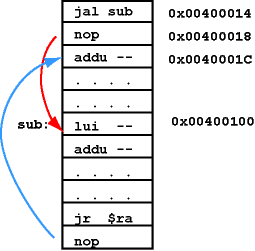The jr Instruction

The
jr
instruction returns control to
the caller.
It copies the contents of $ra into the PC:
jr $ra # PC <― $ra
Usually you think of this as "jumping to the address in $ra."
To make the instruction more general, it can be
used with any register, not just $ra.
Like all jump and branch instructions,
the jr instruction is
followed by a branch delay.
The diagram shows the subroutine returning
to the return address that was loaded into $ra
by the jal instruction in the caller.